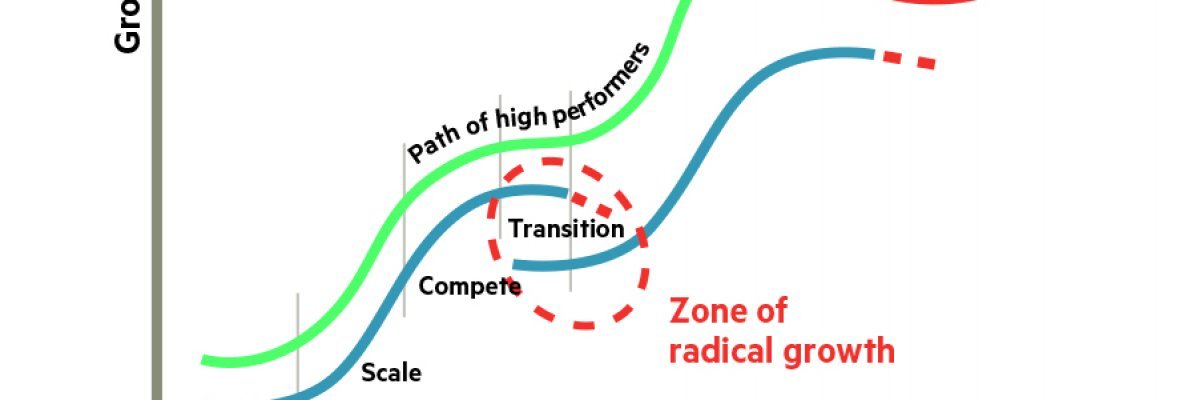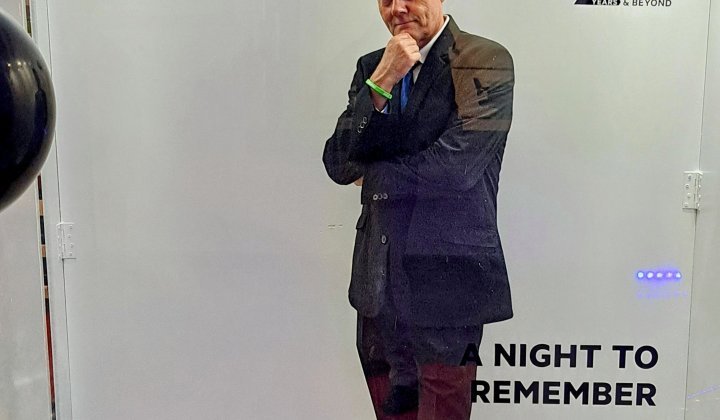In an automation- and artificial intelligence-driven knowledge economy in which disruptions are frequent and accelerated, it is simply impossible to ‘play the game’ the way it used to be played. The rapid development of technology, coupled with changing customer dynamics, has created a mutually-reinforcing vortex which continues to spawn radical new business models. Many of yesterday’s mindsets and capabilities are no longer good enough for tomorrow’s world. As Clayton Christensen wrote in his 1997 book The Innovator’s Dilemma: When New Technologies Cause Great Firms to Fail: “The reason [for why great companies failed] is that good management itself was the root cause. Managers played the game the way it’s supposed to be played.”
In the past we’ve often witnessed history repeating itself. When a company caught old players off guard by implementing a disruptive offering or stepped into a new market, then new competitors would spring out from nowhere. When a company launched a ‘blue ocean’ strategy to conquer a new market, then other players quickly moved in. Competition is, and will remain, fierce and competitors will continue to contest the market share with new innovative offerings. These innovative offerings can be either disruptive – delivering new value propositions – or displacive – copying and improving on the offerings of the first-movers. Either way, companies that fail to innovate will perish.
A great example of this is how innovative mini mills disrupted the large mills in the steel industry (one of Christensen’s favourite examples). Through the combined effect of incremental improvements, the mini mills collectively displaced the larger mills and drove many of these giants into bankruptcy. Yet, not a single integrated steel company at the time, and around the globe, decided to open a mini mill, despite witnessing the mini mills taking their market share.
Here are some of the takeaways:
1. Not all disruptions have to come from a single radical, novel disruptive concept. Many come from being able to combine various, ‘smaller’ innovative ideas and systematically do the right things to gradually displace the leaders.
2. For the first-comers, especially those that have grown and fenced off their kingdoms over the years, it is not enough to merely improve the existing growth trajectories, they need to guard their territory by pursuing disruptive concepts and displacive tactics concurrently.
3. A company needs to continue to consolidate its existing competitive advantage. It must also foster its transient advantage – a management outlook which emphasises that competitive advantages are often short-lived. Unfortunately, to achieve the optimal level of transient advantage, leaders of companies must periodically undergo some form of self-disruption.
4. It is imperative for businesses and individuals to develop the intelligence and the courage to recognise the appropriate timing for self-disruption, and how best to do so. In other words, they must examine their own ‘Double S Curve’ frequently.
Look to the impact
Successful growth, as the accompanying illustration shows, requires the foresight to envision the impact of the shift, the insight of how significantly more one will benefit from the existing growth path and the wisdom to manage the zone of radical growth contextually. At the organisational level, to migrate from the old to the new may require intra-organisational partnership, multi-institutional strategic alliances, or educating the stakeholders within the ecosystem. At the personal level, there are many factors that shape the overall success of a discontinuous change. For instance, if you don’t have a ‘personal board of directors’ to turn to for guidance, a group of people comprising peers, senior figures and even those junior to you who have value to give, then you probably don’t have the ideal support and triggers to help you to squeeze the most out of your zone of transition. In short, effective self-disruption comes from having an audacious vision and integrating that with various innovative actions.

I spend a lot of my time studying the theories and business cases of disruption as well as helping executives to innovate their organisations and disrupt themselves. Over time, I’ve come to realise that in order to get the most out of this zone, they need to time the entry correctly and scrutinise the multiple plausible futures they have envisioned. In order to change they need to be in touch with their personal or organisational growth stage; the flaws and the strengths. When they jump too rashly into this zone and lack the self-knowledge to capitalise on the disruption, then the outcome will inevitably be diluted. Once they have fine-tuned their mindsets and understand the resources at their disposal, I then often encourage them to continuously ask: “For my next step, how can I put in the least effort to increase the contributions to others and maximise the rewards while minimising the risks and lowering the disturbance?”
When assisting leaders to unpack the key factors that enable them or their companies to make effective transitions when pursuing radical growth, I prefer to ask how they question their questions. How to come up with better questions to generate higher value returns becomes more important than finding the answers. This approach allows me to pay attention to the subtle clues into the underlying logic underpinning their outlook. These simple questions enable me to probe deeper into how they translate their thinking into behaviours. Their responses help me to ascertain if an executive is caught in a self-defeating vicious cycle or embarking on a gratifying virtuous cycle. When leaders can clearly see how they SHIFT between these two cycles, I believe they can come up with better questions to catalyse disruption and radical growth.
What is SHIFT?
In the pursuit of radical growth one needs to think smartly about various elements that may affect the progress. In my experience leaders can often be bombarded with an avalanche of daily challenges and do not have the luxury to spend enough time dissociating themselves or their businesses from the past. If you really want to get the most out of radical growth, you first need to sit down and simultaneously analyse both the why you are ready to change and how you will be changing. Then you may want to analyse the mutual reinforcing relations between the why and the how. For example, the why could be rooted in your aspiration to make bigger contributions to customers in a certain segment. The how could be the various displacive tactics you have formulated. You should continually revisit the two and re-examine the why, to provoke new thinking that enables you to formulate smarter hows. Repeat until you are clear about how to achieve maximum rewards with minimal effort, reduced risks and minimum disturbance.
By motivating leaders to question their own Self-expectations, the quality of their Heuristics, their proclivity to take Initiatives and the Fortitude to stand firm when facing adversity while being able to turn negativity to positivity during the interpersonal Transfers between them and others, they are able to manage the transition more meaningfully and successfully. Adopting the SHIFT ethos will also prevent you from being paralysed by the analysis and never taking any action. Some of the simple questions that are helpful to personal and organisations' radical growth may include:
Self-expectations: Am I still attuned to the changes around me with an open mind? What areas in my life are important to me and how do I expect myself to elevate these areas to a higher level? Am I assisting my organisation to accelerate the pipeline of innovation; from ideation to implementation?
Heuristics: Am I thinking correctly and smartly? What are my options? Who can help me? How can I advance from where I am smartly? What do the customers and employees really want? What are the tactics to disrupt or displace my competitors? Who should I partner with?
Initiatives: Am I taking the first step? What are the milestones I have established and what are my evaluation criteria? How can I be more disciplined in bridging my behaviours with the self-expectations and shape my thinking?
Fortitude: Do I know that change is hard? Am I mentally prepared for change? How do I normally respond to adversity and can I do better? Have I assisted myself or my organisation to develop various fail-safe mechanisms?
Transfers: How have I dissociated myself from the less favourable past and transferred the negativity to create a positive future? How can my organisation assist the country to become more inclusive and prosperous through the work we do?
Only when these elements work in harmony do you have the right make up to grow radically and effectively. For example, sometimes leaders might lack flexibility and at other times, battle to take initiative. Unless they actively work on changing that they’ll remain firmly stuck between the heuristic, hands-on aspect of personal growth, and the ability to take initiative.
SHIFT is not a recognised academic term or a fancy research model, it is how I consult and coach. It encourages my clients to question their aims, their decision-making along the self-disruption journey and their actions for radical growth. Over time, clients do realise that they are oscillating between these loops, but by no means are they stuck in one. They have the ability to enable themselves to step out of vicious spirals and place their future on a series of small virtuous cycles when dealing with their own zone of radical growth.
Of course, changing is never easy and it is only through recognising and addressing our limitations that we can really harness opportunities as they arise. You can be your biggest enabler or your biggest enemy on this journey. SHIFT works by constantly interrogating the smartest ways of learning, growing and developing. SHIFT calls for introspection, rather than a gung-ho call for action because stepping into change mindfully is a more powerful way to make growth radical and game-changing. Yes, it’s uncomfortable, but it’s worth it.
Business Actions: What can SHIFT do for your organisation?
Companies are increasingly focused on disruptive innovation, but while they pay lip service to concepts like agility, flexibility and adaptability, most steadfastly refuse to disrupt themselves first. Instead, they remain locked in established cycles which simply cannot work if a new and increasingly responsive way of doing business is to be achieved. As much as individuals should focus on their SHIFT behaviours, so should organisations and those who power them.
Disruptions to the way we do business, from technological advancements to issues like the rise of cryptocurrencies and the battle to retain talent, are increasingly demanding that businesses address their shortcomings and abandon old ways of doing things. This is the sort of balancing act companies like financial institutions are currently facing as they digitise while trying to migrate traditional customers into a mobile world. Some institutions are handling this zone of radical growth better than others. Inevitably those skilfully managing these two overlapping worlds are willing to change from within. Those that fail to make the shift, will have passed up a golden opportunity.
To disrupt and to displace competitors, leaders should SHIFT their growth by paying attention to their personal and organisational Double S Curves




